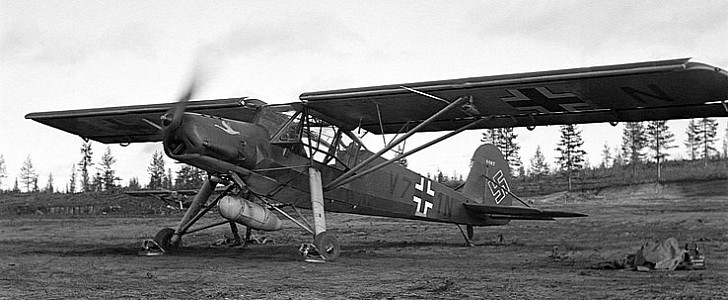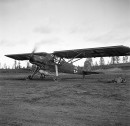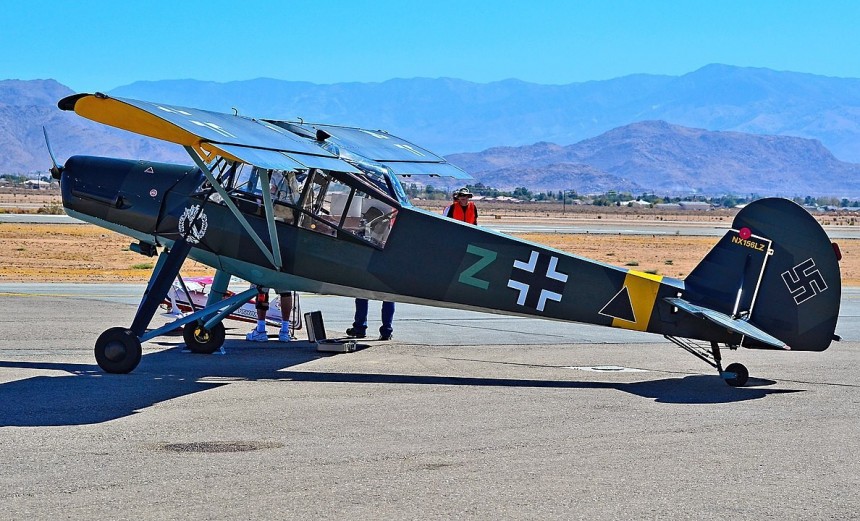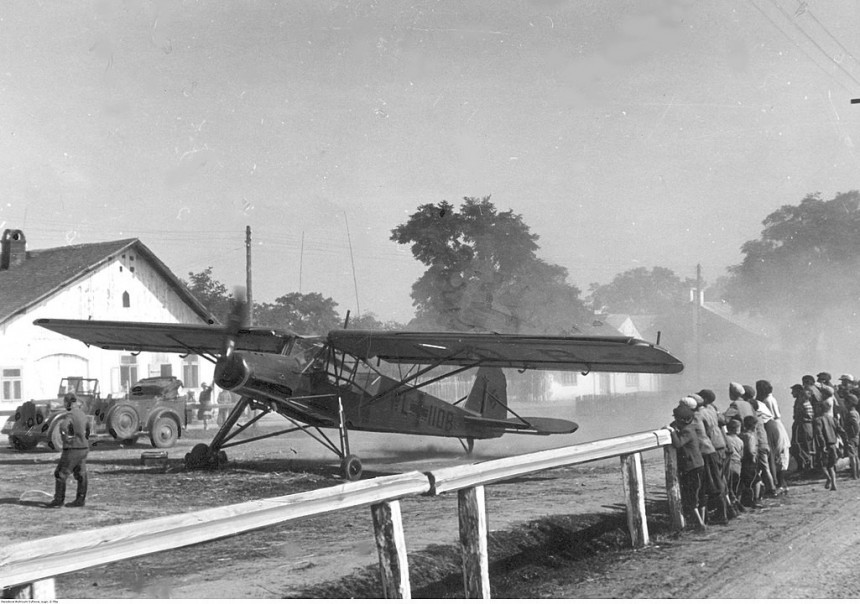If you had to pick one German airplane from the Second World War that served in every single campaign from Barbarossa through the fall of Berlin, most would immediately pick the Messerschmitt Bf-109, and rightly so. But there's another lesser-known Luftwaffe stalwart that can also make that claim.
On the face of it, the Fieseler Fi 156 Storch looked like the most pathetic pipsqueak of a warplane. One you wouldn't want to be caught dead flying in a warzone. But if you think this, know that everyone from Erwin Rommel to Hermann Göring happily sat in the back of these positively adorable Luftwaffe liaison planes. But why? What could be so great about it that the Wehrmacht's Desert Fox and the leader of the Luftwaffe both called their transport of choice?
The answer is more complicated than you'd think. It could have something to do with the Storch's designer, Gerhard Fieseler, an Imperial German ace pilot during the First World War, the same as Göring. So when the newly formed German Air Ministry issued a challenge to its domestic aerospace manufacturers, a design Fieseler was working on for the private/military sector seemed like a sure fit.
The decree, issued by an organization Hermann Göring himself founded in 1935, called for a light, durable, military liaison airplane capable of taking off and landing from a variety of rugged terrains to transport VIP personnel to, from, and around battlefields across Europe in their mad blitzes pushing both east and west which the German's had been planning in secret since the Nazi party rose to power in the early 1930s.
Competing against designs from Messerschmitt and the upstart Seibel company, the Storch easily won with flying colors. Though not a particularly fast airplane, with a top speed in the neighborhood of 110 mph (175 km/h), the Storch's engine was still a robust and well-respected powerplant. It was a V8 engine, an Argus As 10 inverted, air-cooled 773-cubic inch (12.66-liter) unit generating roughly 240 horsepower depending on the altitude.
In many respects, the As 10 was the final aeronautical V8 piston engine of any military significance to see service in a major conflict. It served the Fi 156 Storch admirably from 1937 through 1945 in the German Luftwaffe service. The Storch appeared in droves across all theaters in Europe and North Africa during the war. Erwin Rommel famously chartered a one to survey the advancements of British and American forces under the command of Bernard Montgomery and George S. Patton, respectively.
Unlike most land-based warplanes, the Storch featured folding mono-wings, which allowed them to be easily transported on trucks and flatbed train cars. Its rear seat position could be occupied by a photographer carrying a special camera to take reconnaissance photos or operate an optional Rheinmetall MGF 14 7.92-mm machine gun mounted in a turret at the back of the cockpit.
The aircraft's lightweight and decent power-to-weight ratio for what it was allowed it to take off and land in less than the length of a football field. A factor that turned out to be of great importance in Storch's most historically important mission was the retrieval of the captured Italian dictator Benito Mussolini from Allied captivity. In late July 1943, During Unternehmen Eiche, translated as "Operation Oak" in English and commonly referred to as the Gran Sasso raid.
Originally, a Focke-Achgelis Fa 223 helicopter was intended to transport the Italian dictator from his Allied holding cell in the Gran Sasso d'Italia in the Apennines near the Italian Alps. But when that broke down en route to the mission, the venerable, rugged Fi 156 was chosen to extract Mussolini, German Commando Otto Sorkeny, and their pilot out away from their extract point. Legend had it the Fieseler's V8 struggled to lift the team of three men from their evac-zone. But the mighty Argus A 10 had just enough lifting power to transport get the trio back to base.
The Storch was the last Luftwaffe airplane to be shot down by an American during the war. When a single crew flying a Piper L-4, the military variant of the J-3 cub, strafed a Storch while shooting their M1919 pistols out the window. Nearly 3000 Fi 156s were built between 1937 and 1939. Serving with the Armed Forces of Austria, Belgium, South Africa, Italy, Norway, Serbia, Finland, Egypt, Hungary, and Romania.
Famously, production of the Storch continued after the Liberation of France as the Morane-Saulnier MS.505 Criquet. It served in the French Air Force until the astonishing year 1970. For a pipsqueak little airplane, that's a remarkable military career. Its V8 engine is pretty neat too.
Check back for more from V8 Month here on autoevolution.
The answer is more complicated than you'd think. It could have something to do with the Storch's designer, Gerhard Fieseler, an Imperial German ace pilot during the First World War, the same as Göring. So when the newly formed German Air Ministry issued a challenge to its domestic aerospace manufacturers, a design Fieseler was working on for the private/military sector seemed like a sure fit.
The decree, issued by an organization Hermann Göring himself founded in 1935, called for a light, durable, military liaison airplane capable of taking off and landing from a variety of rugged terrains to transport VIP personnel to, from, and around battlefields across Europe in their mad blitzes pushing both east and west which the German's had been planning in secret since the Nazi party rose to power in the early 1930s.
Competing against designs from Messerschmitt and the upstart Seibel company, the Storch easily won with flying colors. Though not a particularly fast airplane, with a top speed in the neighborhood of 110 mph (175 km/h), the Storch's engine was still a robust and well-respected powerplant. It was a V8 engine, an Argus As 10 inverted, air-cooled 773-cubic inch (12.66-liter) unit generating roughly 240 horsepower depending on the altitude.
Unlike most land-based warplanes, the Storch featured folding mono-wings, which allowed them to be easily transported on trucks and flatbed train cars. Its rear seat position could be occupied by a photographer carrying a special camera to take reconnaissance photos or operate an optional Rheinmetall MGF 14 7.92-mm machine gun mounted in a turret at the back of the cockpit.
The aircraft's lightweight and decent power-to-weight ratio for what it was allowed it to take off and land in less than the length of a football field. A factor that turned out to be of great importance in Storch's most historically important mission was the retrieval of the captured Italian dictator Benito Mussolini from Allied captivity. In late July 1943, During Unternehmen Eiche, translated as "Operation Oak" in English and commonly referred to as the Gran Sasso raid.
Originally, a Focke-Achgelis Fa 223 helicopter was intended to transport the Italian dictator from his Allied holding cell in the Gran Sasso d'Italia in the Apennines near the Italian Alps. But when that broke down en route to the mission, the venerable, rugged Fi 156 was chosen to extract Mussolini, German Commando Otto Sorkeny, and their pilot out away from their extract point. Legend had it the Fieseler's V8 struggled to lift the team of three men from their evac-zone. But the mighty Argus A 10 had just enough lifting power to transport get the trio back to base.
Famously, production of the Storch continued after the Liberation of France as the Morane-Saulnier MS.505 Criquet. It served in the French Air Force until the astonishing year 1970. For a pipsqueak little airplane, that's a remarkable military career. Its V8 engine is pretty neat too.
Check back for more from V8 Month here on autoevolution.











